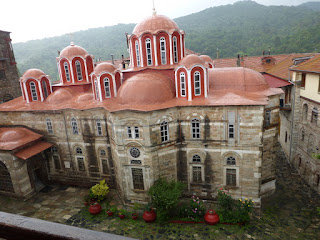Here’s a gardening tip from a monk I met on Mount Athos.
“One. The most important is to put an icon of Saint Trifon in the garden and give him a really good feast day. Two. Rely on God - if one crop is bad he gives you more of something else. Three. Weed by hand and pick off the pests.”
There you have it. Trifon is the third century patron saint of gardeners and wine-growers.
On a map of Greece you will see in the north what looks like a stunted hand with three fingers sticking out into the sea. The top finger is the peninsula of Mount Athos. The ‘Autonomous Monastic State of the Holy Mountain’ is a self-governing state within the Republic of Greece. It has been famous as the spiritual home of Orthodoxy for a thousand years.
A spine of mountain ridge fifty kilometres long and ten kilometres wide rises to the bare summit of the Holy Mountain before plunging down to the sea. Water courses, ravines and valleys run down like ribs on either side. In the west and on plateaus, clearings and terraces is land for farming. The rest is a wild place, bare mountain or thick forest, a source of food to forage and home to boar, foxes, jackals, wolves, reptiles and birds.
About half of the 1800 monks live in twenty monasteries and the rest in smaller communities and hermitages. They come from all over the world, primarily Greece, Cyprus, Romania, Russia, Serbia, and Bulgaria. The community is glibly described as a throwback to medieval Byzantium. Wonder-working icons and relics are channels to the divine; everyday miracles are part of nature; the marvellous deeds of saints are facts not metaphors.Their faith, their way of life, the strange beauty of the place, promise mystery in the ancient sense of truth beyond comprehension.
They are all men. Many women bridle that half the human race is banned from seeing the wonderful sights and treasures, which I have now learned not to bang on about in their presence. I have also learned not to mansplain the ban’s history. The simplest explanation is that in a monastery there is an ‘enclosure’ where women may not go, and in a convent where men may not go. Think of Athos as a big enclosure.
Monasteries have a basic layout. Inside a ring of walls is a stone tower with the treasury and the library, the last refuge against enemies and fire. The focal point is the katholikon, the church, repository of icons and relics. Close by are the refectory and kitchen. In the courtyard a fountain spouts mountain water. The living quarters are in three or four storey buildings with single cells for monks and dormitories for pilgrims. Other rooms house chapels, meeting rooms, laundry, and workshops. Underground is Saint Trifon’s other realm, the wine cellar. Outside the walls are vineyards, orchards and kitchen gardens. Cliff-top monasteries have flamenco skirts of cultivated terraces.
Beyond the cultivated fields thick forest clads all but the highest and most precipitous slopes of the mountain. Monks do not eat meat and female animals are banned, with the exception of cats to keep down the mice and hens to give eggs for high days and tempera for icon painting. So the landscape is free from the flocks of sheep and goats which have scoured hillsides in the rest of the Mediterranean of vegetation and soil. On the secular side of the frontier of Athos the hills are stripped to grey rock and scrub by grazing. On the theocratic side, green hills flourish.
At the beginning of the last century there were up to 10,000 monks. Their numbers shrank until the 1960’s. The land they cultivated has been taken over by trees, so that in the middle of the forest one comes across old orchards of olive and other fruit trees gone wild but still a bounty for a foraging hermit.
Athos is often called the Garden of the Virgin - To Perivoli Tis Panaghias. There are two Greek words for garden. Kipos is the land round the house decorated with flowerbeds and shady places for a barbie. Perivoli is a more utilitarian plot away from the house for growing food, like an allotment. There may be a few flowers in pots and beds around the monastery courtyard but not for decoration. A committed ascetic would avoid taking pleasure in them for their own sake but see them as another way of honouring the Virgin.
Fortunately for us non-hermits the Athos diet and the horticulture that furnishes it are more varied. Fields and terraces are hatched with lines of leeks, celery, chard, beans, onions, kale, spinach, huge blue cabbages and more, or wrapped in shimmering polytunnels forcing peppers, aubergines, courgettes and tomatoes. Stunted vines squat on wire trellises. Regiments of orange, lemon, persimmon, pomegranate, fig, cherry, apple and olive trees muster in ranks. Walls and chainlink fences keep out marauding wild pigs. Beehives provide superb honey. There is space for wheat. This has always been imported.
At the monastery of Konstamonitou tending the flower beds around the katholikon is clearly not on the roster of duties allocated by the abbot. Non-Orthodox are not allowed into church for services so for something to do during vespers I earned my keep by tidying up the planters around the church. With my Opinel knife I deadheaded roses, rooted out bindweed, pruned shrubs. I gave it all a good watering from the fountain. It was pleasant work in the late afternoon sunshine, listening to the chanting from an open church window. A bird in the eves joined in with an exquisite, blackbirdish song, all full of life and praise to touch the heart of an old sceptic. I got an infected finger from a thorn, which I thought was a bit churlish of whoever doles out just deserts.










No comments:
Post a Comment